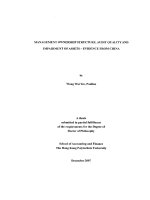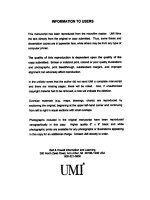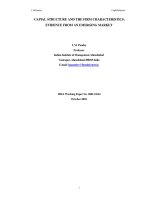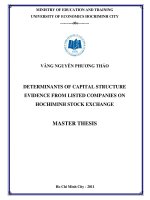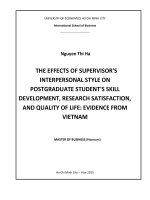Managerial liabilities and executive compensation structure evidence from an exogenous shock
Bạn đang xem bản rút gọn của tài liệu. Xem và tải ngay bản đầy đủ của tài liệu tại đây (437.73 KB, 73 trang )
VIETNAM NATIONAL UNIVERSITY HO CHI MINH CITY
HO CHI MINH CITY UNIVERSITY OF TECHNOLOGY
--------------------
NGUYỄN MINH CHÂU
MANAGERIAL LIABILITIES AND
EXECUTIVE COMPENSATION STRUCTURE:
EVIDENCE FROM AN EXOGENOUS SHOCK
TRÁCH NHIỆM QUẢN LÝ VÀ
CẤU TRÚC LƯƠNG THƯỞNG ĐIỀU HÀNH:
BẰNG CHỨNG TỪ MỘT CÚ SỐC NGOẠI SINH
Major:
Business Administration
Major ID:
8340101
MASTER’S THESIS
HO CHI MINH CITY, July 2023
THIS THESIS IS COMPLETED AT
HO CHI MINH CITY UNIVERSITY OF TECHNOLOGY – VNU-HCM
Supervisor : Nguyễn Thu Hiền, Ph.D
Examiner 1 : Phạm Hà, Ph.D
Examiner 2 : Lê Thị Phương Vy, Ph.D
This master’s thesis is defended at HCM City University of Technology, VNUHCM City on 12/06/2023.
Master’s Thesis Committee:
1. Chairman: Assoc. Prof. Vương Đức Hoàng Quân, Ph.D
2. Secretary: Dương Như Hùng, Ph.D
3. Examiner 1: Phạm Hà, Ph.D
4. Examiner 2: Lê Thị Phương Vy, Ph.D
5. Member: Nguyễn Thu Hiền, Ph.D
Approval of the Chairman of Master’s Thesis Committee and Dean of School of
Industrial Management after the thesis being corrected (if any).
CHAIRMAN OF THESIS COMITTEE
DEAN OF SCHOOL
OF INDUSTRIAL MANAGEMENT
VIETNAM NATIONAL UNIVERSITY - HO CHI MINH CITY
HO CHI MINH CITY UNIVERSITY OF TECHNOLOGY
SOCIALIST REPUBLIC OF VIETNAM
Independence – Freedom - Happiness
THE TASK SHEET OF MASTER’S THESIS
Full name: Nguyễn Minh Châu
Student ID: 2070224
Date of birth: 12/07/1993
Place of birth: An Giang
Major: Business Administration
Major ID: 8340101
I. THESIS TITLE:
Managerial Liabilities and Executive Compensation Structure: Evidence from
an Exogenous Shock
(Trách Nhiệm Quản Lý và Cấu Trúc Lương Thưởng Điều Hành: Bằng Chứng
Từ Một Cú Sốc Ngoại Sinh)
II. TASKS AND CONTENTS:
-
Propose a model that examines the impact of manager responsibilities on
executive compensation structure
-
Analyze and test the above model
-
Suggest managerial implications based on the research results
III. THESIS START DAY: 15/06/2022
IV. THESIS COMPLETION DAY: 04/05/2023
V. SUPERVISOR: Nguyễn Thu Hiền, Ph.D
Ho Chi Minh City, date…
SUPERVISOR
HEAD OF DEPARTMENT
(Full name and signature)
(Full name and signature)
DEAN OF SCHOOL OF INDUSTRIAL MANAGEMENT
(Full name and signature)
i
ACKNOWLEDGEMENT
First of all, I would like to thank the profressors of School of Industrial
Management – Ho Chi Minh City University of Technology – VNU-HCM, who
have taught valuable knowledge to me during my study.
I am deeply grateful to Dr. Nguyen Thu Hien, who dedicatedly guided me so that I
could successfully complete this research. Thanks to her guidance and help, I was
able to complete this thesis.
I would like to thank my friends and fellow students who have supported me during
the last period of study and research.
In particular, I would like to thank my family for always supporting and
encouraging me throughout my study. My family's support is essential to my
success in completing my thesis and achieving my goals.
In the process of writing the thesis, it is inevitable that mistakes can be made. I
would like to receive your comments and suggestions so that the thesis can be
better.
Ho Chi Minh City, 21 July 2023
Author
Nguyễn Minh Châu
ii
ABSTRACT
To analyze how the legal responsibilities of D&Os affects their compensation
package, this study makes use of an exogenous shock caused by a change in Nevada
corporation law in 2001 that greatly improves the protection of D&Os from
litigation risks. Research results show that companies incorporated in Nevada had a
larger proportion of long-term incentive plans (LTIP) than a sample of control
companies that were formed outside of the state. The enterprise's use of LTIP as a
tool to align the interests of D&O with the interests of the shareholders of the
enterprise is effective, supporting the hypothesis that there is an agency problem,
according to the litigation discipline hypothesis; therefore, the legal protection
mechanisms for D&O will lead the company to increase the proportion of LTIP in
the entire compensation structure of D&O to encourage managers to actively add
value to shareholders.
iii
TĨM TẮT LUẬN VĂN
Để phân tích trách nhiệm pháp lý của thành viên HĐQT và cán bộ quản lý
(Directors and Officers - D&O) ảnh hưởng như thế nào đến cấu trúc thu nhập của
họ, nghiên cứu này sử dụng cú sốc ngoại sinh gây ra bởi sự thay đổi trong luật
doanh nghiệp của tiểu bang Nevada, Hoa kỳ, vào năm 2001 mà đã giúp cải thiện
đáng kể khả năng bảo vệ D&O khỏi các rủi ro pháp lý khi thực thi các trách nhiệm
của mình. Kết quả nghiên cứu cho thấy các cơng ty được thành lập ở Nevada có
chính sách thù lao với tỷ trọng mức thù lao khích lệ dài hạn (Long-term incentive
plans, hay LTIP) lớn hơn so với các công ty tương tự được thành lập bên ngoài tiểu
bang Nevada. Điều này được hiểu rằng việc doanh nghiệp sử dụng LTIP như một
công cụ để gắn kết lợi ích của D&O với lợi ích của các cổ đông của doanh nghiệp là
hiệu quả, ủng hộ cho giả thuyết cho rằng có tồn tại vấn đề đại diện theo litigation
discipline hypothesis; do vậy, các cơ chế bảo vệ pháp lý cho D&O sẽ dẫn đến việc
công ty phải tăng tỷ trọng LTIP trong toàn bộ cấu trúc thu nhập của D&O để khích
lệ ban điều hành tích cực gia tăng giá trị cho cổ đông.
iv
THE COMMITMENT OF THE THESIS’ AUTHOR
I hereby declare that in addition to the cited references, the contents of this thesis
are the results of my personal research under the guidance of Dr. Nguyen Thu Hien.
Ho Chi Minh City, 21 July 2023
Author
Nguyễn Minh Châu
v
TABLE OF CONTENTS
ACKNOWLEDGEMENT ........................................................................................ I
ABSTRACT ..............................................................................................................II
TÓM TẮT LUẬN VĂN ......................................................................................... III
THE COMMITMENT OF THE THESIS’ AUTHOR ....................................... IV
TABLE OF CONTENTS ......................................................................................... V
TABLE OF TABLES ............................................................................................. IX
TABLE OF FIGURES ............................................................................................. X
CHAPTER 1: INTRODUCTION ............................................................................ 1
1.1. BACKGROUND ............................................................................................. 1
1.2. RESEARCH OBJECTIVE ................................................................................ 4
1.3. RESEARCH OBJECTS AND SCOPES ............................................................... 4
1.4. RESEARCH METHODOLOGY ........................................................................ 5
1.5. RESEARCH SIGNIFICANCE ........................................................................... 5
1.6. RESEARCH STRUCTURE............................................................................... 6
CHAPTER 2: LITERATURE REVIEW ................................................................ 7
2.1. CONCEPTS AND DEFINITION........................................................................ 7
2.1.1. Executive Compensation Structure ................................................. 7
2.1.2. Annual base salary ........................................................................... 7
2.1.3. Annual Bonus .................................................................................. 8
2.1.4. Long-term Incentives....................................................................... 8
2.1.5. Stock ................................................................................................ 9
2.1.6. Stock options ................................................................................. 10
2.1.7. Option Risk Metrics - Delta .......................................................... 10
2.1.8. Option Risk Metrics - Vega ........................................................... 10
vi
2.1.9. Exogenous shock ........................................................................... 11
2.2. THEORETICAL FRAMEWORK ..................................................................... 12
2.2.1. Corporate Governance ................................................................... 12
2.2.2. Principal-agent problem ................................................................ 12
2.2.3. Vega and Delta used in measuring incentives pay ........................ 15
2.3. PREVIOUS RESEARCHES ............................................................................ 15
2.3.1. Research on managerial liability and corporate innovations of
Guan, Zhang, Zheng and Zou .................................................................. 15
2.3.2. Research on managerial incentives of Coles, Daniel and Naveen 16
2.3.3. Research on calculating stock option by Core and Guay .............. 17
2.3.4. Research on CEO compensation of Core, Holthausen and Larcker
................................................................................................................. 17
2.3.5. Research of Liability protection, director compensation and
incentives of Aguira, Burns, Mansib and Wald ...................................... 18
2.3.6. Research on Executive Compensation and the Maturity Structure of
Corporate Debt of Brockman, Martin and Unlu...................................... 19
2.4. IDENTIFY THE OPPORTUNITY TO RESEARCH .............................................. 19
2.5. SUGGESTED MODEL AND HYPOTHESES .................................................... 20
2.5.1. Suggested research model ............................................................. 21
2.5.2. Research hypotheses ...................................................................... 22
CHAPTER 3: DATA AND METHODOLOGY ................................................... 23
3.1. RESEARCH PROCESS ................................................................................. 23
3.1.1. First period ..................................................................................... 24
3.1.2. Second period ................................................................................ 24
3.1.3. Third period ................................................................................... 24
3.2. DATA SOURCES ......................................................................................... 25
3.2.1. Data for vega and delta .................................................................. 25
3.2.2. Data for control variables .............................................................. 25
3.2.3. Sample selection ............................................................................ 26
vii
3.3. METHODS USED IN THE RESEARCH ........................................................... 26
3.3.1. Propensity Score Matching............................................................ 26
3.3.2. Variables ........................................................................................ 28
3.3.3. Measurement of volatility.............................................................. 29
3.3.4. Model Specification – Baseline analysis ....................................... 29
3.3.5. Dynamic Model ............................................................................. 30
3.4. METHOD TO TEST HYPOTHESES ................................................................ 31
3.4.1. Difference-in-differences analysis ................................................ 31
3.4.2. Rationale to employ difference-in-differences analysis ................ 32
3.5. STEPS TO TEST THE MODEL ....................................................................... 33
3.5.1. Treatment group ............................................................................ 33
3.5.2. Control group................................................................................. 33
3.5.3. Conducting analysis....................................................................... 34
3.5.4. Robustness Check .......................................................................... 34
CHAPTER 4: RESULTS AND DISCUSSIONS .................................................. 36
4.1. PROPENSITY SCORE MATCHING & BALANCE CHECK ................................. 36
4.1.1. Result from Propensity score matching......................................... 36
4.1.2. Assessing balance .......................................................................... 37
4.2. SUMMARY STATISTICS .............................................................................. 38
4.3. BASE LINE REGRESSION RESULT ............................................................... 39
4.3.1. The result with control variables ................................................... 39
4.3.2. Vega ............................................................................................... 40
4.3.3. Delta............................................................................................... 40
4.4. DYNAMIC MODEL REGRESSION RESULT .................................................... 41
4.4.1. Vega ............................................................................................... 42
4.4.2. Delta............................................................................................... 43
4.5. ROBUSTNESS CHECK ................................................................................. 44
4.5.1. Alternative matching samples ....................................................... 44
4.5.2. Controlling firm age ...................................................................... 45
viii
4.6. DISCUSSION............................................................................................... 46
4.6.1. Hypotheses that are supported ....................................................... 46
4.6.2. Hypotheses that are not supported ................................................. 47
CHAPTER 5: CONCLUSION AND MANAGEMENT IMPLICATIONS ...... 48
5.1. RESULTS SUMMARY .................................................................................. 48
5.2. MAIN CONTRIBUTIONS .............................................................................. 48
5.3. MANAGEMENT IMPLICATIONS .................................................................. 49
5.3.1. Solving the problem of principal-agent ......................................... 49
5.3.2. The design of compensation structure ........................................... 50
5.3.3. Compensation structure that attracts talent ................................... 50
5.4. LIMITS AND SUGGESTIONS ........................................................................ 50
REFERENCES ........................................................................................................ 52
APPENDIX .............................................................................................................. 55
ix
TABLE OF TABLES
Table 2.1. Research Hypotheses .............................................................................22
Table 3.1. Variables used in the study ...................................................................29
Table 3.2. Dummy variables by year .....................................................................31
Table 4.1. Probit Model ..........................................................................................36
Table 4.2. T-test comparison ..................................................................................37
Table 4.3. Descriptive Statistics .............................................................................38
Table 4.4. Baseline Regression of Vega .................................................................40
Table 4.5. Baseline regression of Delta ..................................................................40
Table 4.6. Dynamic regression of Vega .................................................................42
Table 4.7. Dynamic regression of Delta .................................................................43
Table 4.8. Regression of vega - Alternative matching samples ...........................44
Table 4.9. Regression of delta - Alternative matching samples ..........................44
Table 4.10. Regression of Vega, controlling for firm age ....................................45
Table 4.11. Regression of Delta, controlling for firm age ....................................46
Table 4.1. Probit Model ..........................................................................................55
Table 4.2. T-test comparison ..................................................................................55
Table 4.3. Descriptive Statistics .............................................................................55
Table 4.4. Baseline Regression of Vega .................................................................56
Table 4.5. Baseline regression of Delta ..................................................................56
Table 4.6. Dynamic regression of Vega .................................................................57
Table 4.7. Dynamic regression of Delta .................................................................57
Table 4.8. Regression of vega - Alternative matching samples ...........................58
Table 4.9. Regression of delta - Alternative matching samples ..........................58
Table 4.10. Regression of Vega, controlling for firm age ....................................59
Table 4.11. Regression of Delta, controlling for firm age ....................................59
x
TABLE OF FIGURES
Figure 2.1. Managerial liability and Corporation Innovation model ........................16
Figure 2.2. Managerial Liability and Compensation package, bid premium and
takeover success model .............................................................................................19
Figure 2.3. Suggested Research Model .....................................................................21
Figure 3.1. Research Flowchart ................................................................................23
1
CHAPTER 1: INTRODUCTION
1.1. Background
Directors and officers (D&Os) of companies are generally risk-averse when making
corporate decisions that put the values of the company and the shareholders at risks,
while shareholders are interested in risky projects as they could enjoy the most
values added from these projects. Since incentive compensation, a proportion of
compensation package that varies with the value of shareholders, will encourage
managers to take value-added and risky projects as doing so will increase the value
of CEO’s compensation, executive compensation structure therefore plays a pivotal
role to align executive interests with those of shareholders and embolden executives
to become more venturous. Various prior researches have shown that when there are
intense conflicts between shareholders and managers, incentive compensation
appears to be effective in aligning the benefits of managers and shareholders.
Prior researches have shown that D&Os require larger compensation package to
remunerate for the probable litigious and financial loss from not having a
mandatory law that protects them against legal liability as in the research of
(Aguira, Burnsa, Mansib, & Wald, 2012). The research of (Brockman, Martin, &
Unlu, 2010) introduces the concepts of vega and delta, representing the incentive
proportion of D&O’s pay, as a mechanism to motivate risk-taking behavior of
D&Os to align their interests of those of the shareholders. In a study of an
exogenous shock to D&O liability risk from the adoption of a new law, (Guan,
Zhang, Zheng, & Zou, 2021) find that the exemption of D&Os liability risk can lead
to higher level of corporate innovation since executives are relieved from liability
risks and invest more in R&D projects. From the aforementioned studies, it is
observable that an issuance of a new law that exempts the D&Os from legal liability
risk can dramatically change their behaviors. In order to contribute to the current
literature on executive compensation package and suggest management implications
to achieve higher efficiency in activities of business administration, this research
2
attempts to see how a change in legal liability influences executive compensation
structure.
Having an appropriate executive compensation structure can lead to the prosperity
of a corporation. First and foremost, it motivates the D&Os to align their benefits
with the benefits of the company and the shareholders, paving the way for
perseverant growth in long-term value of the company. An executive compensation
structure that places an emphasis on the long-term incentives such as restricted
stocks and stock options can encourage the D&Os to make managerial decisions
that concentrate on the long-term value of the company rather than short-term goals.
On the other hand, a large compensation package without a relevant executive
compensation structure may not be fruitful. Therefore, it is essential to have
profound knowledge of the executive compensation structure under the impact of
exogenous shock in order to achieve a structure coinciding with corporate strategic
priorities.
In 2001, corporate law in Nevada experienced an unanticipated change, mandating
the exemption of the legal liability of directors and officers. This change serves as a
useful quasi-exogenous shock to scrutinize the impact that the waiver of D&Os
liability has on executive compensation structure. The shock facilitates the research
due to the abundance of data before and after the event. Research of (Guan, Zhang,
Zheng, & Zou, 2021) introduces the two crucial hypotheses concerning the riskpreference of D&Os regarding the change in legal liability: the costly litigation
hypothesis and the litigious discipline hypothesis. These hypotheses suggest
different directions of effect of change in legal liability on the behavior of D&Os,
providing a background for conducting research on the risk-preference of D&Os.
Following (Guan, Zhang, Zheng, & Zou, 2021), this research examines the impact
of waiver of legal liability on the executive compensation structure by observing the
change in the behavior of D&Os according to the two hypotheses. It is conjectured
that the exemption from D&Os liability will render long-term incentives less
desirable in settling the conflicts between managers and owners (costly litigation
hypothesis). When the D&Os have protection from waiver of legal liabilities, the
3
agency problem becomes less intense and D&Os are encouraged to invest in
projects that create long-term value for the company without the necessity of
utilization of long-term incentives. Therefore, when D&Os legal liability waiver is
adopted, a reduction in long-term incentives pay is expected. The company now
does not need to pay a long-term incentives as high as it did before to motivate its
D&Os to align their interests with the company.
On the contrary, agency theory hypothesis forecasts that due to diminished
shareholder discipline as a result of exemption from D&Os liability, the D&Os
have a tendency of living a quiet live, avoiding engaging in development projects
that create long-term value for the company. Therefore, in order to embolden the
D&Os to create long-term value for the company, long-term incentive appears to be
more preferable (following litigation discipline hypothesis of (Guan, Zhang, Zheng,
& Zou, 2021)). Since shareholder discipline is lessened, D&Os tend to become less
motivated in creating long-term value for the company. Using long-term incentives
pay as an instrument to align the interests of D&Os and shareholders is vital.
It is intriguing to discover what modification could occur to executive compensation
structure when there is an exogenous shock such as change in corporate law. In the
two hypotheses, the waiver of D&Os legal liability can impact the long-term
incentives in two opposite directions. Empirically, this research attempts to examine
what happens to the compensation structure when managerial liabilities change
under an exogenous shock. Specifically, the research attempts to comprehend how
the weight of long-term incentives (long-term incentives pay as a proportion of total
compensation package) in the compensation package changes in correspondence
with the change in corporate law.
In general, incentive compensation helps reduce D&Os' risk-aversion tendency,
lessening the owner-manager conflict of interest. As a result of the firm's D&O
liability waiver, a reduction in incentive compensation in the CEO pay package is
anticipated (costly litigation hypothesis). Following (Guan, Zhang, Zheng, & Zou,
2021), the research studies the effect using the DID technique and an
unexpected change in Nevada company law in 2001 as a quasi-exogenous shock.
4
However, it is noted that the use of D&O liability waivers may undermine
shareholder discipline, potentially leading to a higher need for incentive pay in
executive compensation packages. Therefore, empirical research is necessary to
assess the direction of the influence of D&O liability waiver on incentive pay.
1.2. Research Objective
This research has two main objectives:
Firstly, this research endeavors to see whether the introduction of a new corporate
law as an exogenous shock to protect the D&Os from the legal liability risk affects
the executive compensation structure.
Secondly, this research attempts to determine the direction of the impact of liability
exemption on the executive compensation structure as evidence for counter
hypotheses, costly litigation hypothesis and the litigious discipline hypothesis.
1.3. Research Objects and Scopes
Since the introduction of a new corporate law in Nevada in 2001 that affects
different corporations in the state, there are several changes in the activities of these
corporation. The research objects comprise of the companies that incorporated in
the state before the passing of the new law and remained incorporated in the state
after the passing of the new law in order to discover the impact the law has on the
compensation package of D&Os of these companies.
The research compares two groups of firms. The treatment group includes
companies incorporated in Nevada. Propensity score matching will be employed to
select the companies in the control group, including companies that are never
incorporated in Nevada.
The scopes of the research is around the year of 2001, the year when the new law is
effective. The period of time to be investigated will be 3 years before, the year 2001
and years after that. By using the wide array of different year span, it is possible see
5
how such an exogenous shock influences the change in compensation structure
throughout a period of time.
1.4. Research Methodology
Following (Guan, Zhang, Zheng, & Zou, 2021), this research employs differencein-differences method by doing an analysis over the years around the year 2001,
when the change in corporate law of Nevada took place. This research attempts to
see whether executive compensation structures of companies incorporated in
Nevada differ before and after the adoption of this law. The reason why differencein-differences analysis is used is that the research desires to attribute the change in
executive compensation structure to the change in law on managerial liability,
showing that the difference in compensation structure takes place after the law
change rather than before the law change.
This research also attempts to uncover the difference in the change of executive
compensation structure of companies of various market capitalizations. Since the
results may be inconsistent among enterprises of dissimilar sizes, the research
strives to find when and where the change of compensation structure is most
pronounced.
1.5. Research Significance
This study adds a number of new ideas to the current literature. Since the D&Os are
benefited from the long-term incentives such as restricted stock and options, they
align their benefits with the shareholders in creating long-term value for the
company. The significance of the research is to determine the impact the D&Os
legal liability waiver has on the executive compensation package. If the result
concurs with the costly litigation hypothesis, which means the D&Os are
encouraged to contribute more to the long-term value of the company without the
necessity of long-term incentives, the long-term incentives can be reduced without
consequences on the efficacy of the management of the company. However, if the
6
result from the research concurs with the litigation discipline hypothesis, which
means the D&Os have a lesser motivation in creating more value for shareholders,
the long-term incentives need to be increased to encourage the D&Os due to the
alignment of interests between managers and owners.
The result from this research can provide management implications in developing a
suitable and successful executive compensation package that can generate the
largest benefits for shareholders in comparison with the expense of compensation
package. An appropriate executive compensation structure should be compatible
with the interests of both D&Os and shareholders, helping the company achieve its
long-term goals and maximize its long-term value. However, an irrelevant executive
compensation structure proves to be impractical in creating expected value that the
shareholders need, and limits the prospects of the company in the competition with
other businesses on the market. Therefore, this research can provide insight to help
the Board of Directors of the company develop a more valuable executive
compensation structure for the company and shareholders.
1.6. Research Structure
This research has five chapters:
Chapter 1: Introduction
Chapter 2: Literature Review
Chapter 3: Data and Methodology
Chapter 4: Results and Discussion
Chapter 5: Conclusion and Management Implications
7
CHAPTER 2: LITERATURE REVIEW
2.1. Concepts and Definition
2.1.1. Executive Compensation Structure
According to (Bebchuk & Grinstein, 2005), pay has increased significantly
compared to the rise that may be attributed to adjustments in firm size, performance,
and industry classification during the period from 1993 to 2003. Research of (Faria,
Martins, & Brandão, 2014) shows a significant and favorable relationship between
CEO pay and company performance. There are multiple components of the
executive remuneration package. Different firms have fairly different organizational
structures. However, the compensation package often consists of long-term
incentives, which are strongly reliant on the long-term value of the firm, and shortterm benefits, which are correlated with the short-term performance of the company
but not the long-term success. Short-term and long-term benefits are incorporated in
the remuneration; the former includes an annual salary and short-term incentives
like bonuses, while the latter comprises restricted stocks and stock options.
According to (Kuepper, 2022), the types of executive compensation comprise of
cash compensation, option grants, differed compensation, long-term incentive plans,
retirement packages and executive perks. The aforementioned elements can also be
divided into fixed payments, such an annual base salary, and incentive payments,
particularly long-term incentives like stock options and restricted stocks. Depending
on the firms and the specifics of the economic and regulatory environment,
executive remuneration structures vary substantially.
2.1.2. Annual base salary
There are differences between annual compensation and annual base salary. Base
salary is the starting salary an employee receives, exclusive of benefits and bonuses.
It is the amount of pay an employee earns in return for their services. The base wage
8
of an employee may be specified as a weekly, monthly, or yearly compensation as
well as an hourly rate.
Not all kinds of remuneration are included in base pay. Base pay often excludes
incentive-based pay. An employee's base salary is often the least amount they can
anticipate receiving during a given pay period.
Although D&Os are paid monthly, the base pay is often represented in the executive
compensation package as the amount they earn annually. The annually base
salary varies significantly between firms.
2.1.3. Annual Bonus
Annual bonuses are adjusted based on performance. D&Os have a tendency to add
more value to the organization owing to motivation if they are convinced they can
benefit from their accomplishments. Growth in sales, profit, or market share may be
utilized as indicators of performance. However, according to (Mcclure, 2021), it
might be challenging to calculate the right remuneration for performance using
straightforward metrics. The effectiveness of an executive's performance is not
always accurately measured by financial measures and annual share price increases,
considering these measures may be impacted by a variety of events in the corporate
environment.
A bonus is a type of payment which is not promised and is often given following
the conclusion of a certain event. It is a form of monetary reward that goes beyond
the recipient's typical payment obligations, according to (Bloomenthal, 2022).
However, in general, bonuses are performance-based, meaning that a firm
distributes them according to how an individual or group of employees performs
to company goals. There are numerous different sizes and types of bonuses.
2.1.4. Long-term Incentives
There are many kinds of stock option, but long-term incentive stock option is
different. According to (Cussen, 2022), an incentive stock option is a different kind
of stock option that is often exclusively provided to important personnel and senior
9
management. A long-term incentive plan is defined as a corporate rule that
compensates employees for achieving particular objectives that boost the value of
shareholders (Kenton, 2022). Long-term incentive is the element of the CEO
compensation package that has greatest weight. D&Os are encouraged to contribute
toward the business's strategic goals with long-term incentives, which is
advantageous to the shareholders. Long-term incentive is provided to D&Os as
restricted stocks and compensation that is based on stock such as call options, which
often has a performance period of three to five years, during which time the
executive is not paid from the incentive until the performance period has ended. As
a result, the long-term incentive effectively aligns the interests of shareholders and
D&Os.
2.1.5. Stock
Stock ownership is the most powerful performance driving factor, according to
earlier studies. The motivation from stocks is far greater than the motivation that
comes from options. When stock is utilized as an incentive, the D&Os behave more
like shareholders since the agency problem is much alleviated. According to
(Mcclure, 2021), when CEOs own shares rather than options, they may actually
have their interests connected to shareholders.
The overall indicators used to gauge the success of the company tend to increase
when the D&Os are promised equity in exchange for their performance. In
accordance with the long-term expansion in the company's worth, their entire pay
package will increase, and so will the percentage of long-term incentives in that
package.
Companies can utilize stock options as a form of pay for their staff. According to
(Barnes, 2022), this offered smaller businesses with fewer budgets a crucial
strategic edge since they could save money by issuing more and more alternatives
without incurring any costs in the process. In this approach, management and
employees may benefit from the company's expansion and success.
10
2.1.6. Stock options
In addition to shares, stock options can be used as a mechanism to link the financial
gains of D&Os with those of the shareholders. However, compared to stock, stock
options offer a lot of drawbacks. According to (Mcclure, 2021), options may
significantly skew risk because executives may profit greatly from options when the
value of their shares increases, but executives fare no worse when share prices
decline. It is obvious that stock options cannot reconcile D&Os and shareholders'
interests with the same efficiency as stock does. Additionally, because stock options
have a time limit, D&Os are encouraged to concentrate on improving financial
indicators in the near future, as (Mcclure, 2021) claims that executives are
incentivized to merely focus on the upcoming quarter and disregard the longer-term
interests of shareholders in order to keep the share price moving up so that options
will remain in the money. In this case, the link between interests of D&Os and
shareholders is not as fortified as in the case of stock incentive.
2.1.7. Option Risk Metrics - Delta
According to (Summa, Investopedia, 2022), one of the key risk indicators that
experienced options investors examine and use into their trading methods is delta.
The first Greek, known as Delta, expresses how much the price of an option is
anticipated to vary for each $1 that the price of the underlying asset or index moves.
Since the value of a call option rises in line with the price of the underlying asset,
call options have a positive delta. (Fernando, 2023) claims that financial contracts
known as call options provide the buyer the right, but not the duty, to purchase a
stock, commodity, or other asset at a defined price and within a certain time frame.
On the other hand, put options will have a negative delta since the value of the put
option is inversely proportional to the value of the underlying asset.
2.1.8. Option Risk Metrics - Vega
Vega assesses the risk related to alterations to implied volatility or the projected
volatility of the price of an underlying asset. Vega looks at changes in forecasted
11
volatility, while delta looks at actual price fluctuations. According to (Frederick,
2021), Vega measures the rate of fluctuation in the price of an option for each 1%
change in the implied volatility of the base asset. Volatility increases the underlying
asset's susceptibility to significant swings, which Vega takes into consideration
when setting option pricing. When Vega falls, both call and put options lose
value. When Vega rises, both call and put options gain value. Vega is defined as a
fluctuation in the price of a derivative proportional to a 1% fluctuation in the
implied volatility of the base asset. In order to comprehend what this means, it is
necessary to first define implied volatility along with the way it is calculated. The
projected volatility of the underlying asset is referred to as implied volatility. A
greater implied volatility indicates that the stock's price is more unpredictable. Price
fluctuations should become more pronounced as volatility rises. Research of
(Armstrong & Vashishtha, 2012) also shows that vega provides CEOs with
incentives to raise systematic risk but not idiosyncratic risk in their organizations.
2.1.9. Exogenous shock
An unexpected incident that has an impact on the economy exogenously is referred
to as an exogenous economic shock. There are several definitions of economic
shock. According to (Reed, 2020), economic shock is defined as any unanticipated
occurrence that has a significant, unanticipated effect on the economy. Exogenous
shocks can have a big impact on the economy, triggering abrupt changes in
investment, consumption, and production. Aside from shifting the supply and
demand of goods and services, such shocks can also cause financial market
disruptions, currency rate adjustments, and other changes.
Economic shocks can be solitary, short-term, large-scale, exogenous, or any
combination of these. The necessary D&Os waiver of legal liability is the external
shock described in this study. It is important to look at how this external shock
affects the CEO compensation package considering that it is a surprise.
12
2.2. Theoretical Framework
2.2.1. Corporate Governance
Definition
There are many ways to define Corporate governance. In order to govern
themselves and carry out their obligations to investors and other stakeholders,
stockholders, executive management, and the board of directors utilize a wide
variety of rules and procedures together referred to as corporate governance. The
protection of shareholders is a key concern of corporation law and corporate
governance, while opinions on the most effective approaches vary.
The main purpose of corporate governance
According to (Claessens, 2006), corporate governance is linked to increased
efficiency, higher returns on equity, reduced cost of capital, and better treatment of
all stakeholders. The interests of shareholders, board members, management, and
staff members are all aligned under excellent corporate governance, which
establishes transparent rules and regulations. It encourages confidence among
voters, investors, and public officials. Stakeholders and investors can get a clear
image of an organization's trajectory and ethical standards thanks to corporate
governance. It is encouraged to pursue opportunities, incentives, and long-term
financial viability. It might render raising finance simpler. It is a method for
enduring success and perseverance. Research of (Monica-Violeta, Ligia-Vaidean,
Popa, & Safta, 2022) also demonstrates corporate governance's impact on
sustainable development.
2.2.2. Principal-agent problem
The theoretic framework of the research is the principal-agent problem, which is the
divergence in risk preference between managers and owners.
